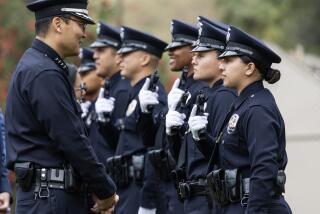‘Broken windows’ policing isn’t broken, says criminologist George L. Kelling

Criminologist George L. Kelling is the co-father of the “broken windows” theory.
- Share via
It was a simple, potent idea: a broken window, left unrepaired, invites disorder. Criminologist George L. Kelling and the late James Q. Wilson published their “broken windows” theory 33 years ago. It was taken up by major police departments, including the LAPD, as part of community policing. It called for police and community engagement to prevent local crime, down to petty offenses, and to create order as an end in itself. The mechanism was interrupting minor offenses before they could snowball and open the door to serious, perhaps violent crime. Now, since fatal police encounters with black men in Missouri and New York began with small offenses — walking in the street, selling untaxed cigarettes — there have been calls to end “broken windows” policing. But Kelling, an emeritus professor at Rutgers University and a fellow at the Manhattan Institute, says “broken windows” still works.
Do people confuse and conflate broken windows with “zero-tolerance policing” or “stop, question and frisk” practices?
Yes. The other day I read that a Delaware police chief said his department was going to do broken windows with steroids. I find that pretty scary because that smacks of zealotry.
Broken windows is a tactic, an essential part of community policing that works with the community to identify problems and set priorities. It doesn’t matter what problems police are up against, they need partners to resolve them, whether it’s squeegee men or homeless in the subway. Broken windows is a tactic within community policing strategy.
An essay on the Atlantic website — it was the Atlantic Monthly magazine that first published your broken windows thesis in 1982 — suggested that broken windows as it’s practiced now gives police carte blanche to overreact.
At times, absolutely. That’s where I’m bothered by its confusion with zero tolerance. Zero tolerance suggests you don’t warn, you immediately arrest. We don’t want police to just be making arrests. We want them to find solutions and at times that solution is simply deciding not to do anything, or saying, “You know you’re not supposed to be doing this, move along.” Robert Peel [a British policing pioneer] said that successful policing is measured by the absence of crime, not the activities once it occurred. Arrests are not necessarily a desirable outcome.
You and New York Police Department Commissioner William J. Bratton, the former LAPD chief, wrote in the current issue of City Journal that given the NYPD’s overall record, the use of force that caused Eric Garner’s death over selling “loosies” — untaxed single cigarettes — was “anomalous.” Why?
Had I been asked to look at the problem of “loosies,” my approach would have been: What is the problem? How did it come to be? Who’s calling the police about it? What are the consequences [of police actions]?
They sent the police out — to do what was unclear. The only available tool they believed they had was to make an arrest. That might have been the case, but there might have been alternate things they could have done as well. Even at that, there’s an enormously small number of deaths from interactions around disorderly behavior. That’s what I meant by anomaly.
In New York, summonses for broken windows violations such as public drinking or bike-riding on sidewalks are disproportionately issued to young black and Latino men. Yet there is polling evidence of support for such enforcement in those same communities.
That’s the paradox and the difficulty. You meet with the African American community and they have two complaints: about the aggressiveness and at times brutality of police, but even more about police not paying attention. They want “this person” dealt with, but they don’t want “these people” [the community at large] arrested or imprisoned.
The demand for order is very strong in the African American community. In New York City, even given all the demonstrations, I could take you to neighborhoods and ask people to identify five major problems and I’m virtually certain at least three would be youths drinking in the park, prostitutes hustling fathers in front of their children, public urination and defecation. If you go to Times Square and talk to the business improvement district, you get the same kind of complaints as in the most troubled minority neighborhoods.
You regard the work of broken windows enforcement as not just the police’s responsibility.
In the New York subway [where broken windows theories were applied in the early 1990s], there were typical theft problems, and police are pretty good at that. But you still have a population that is genuinely and in many respects tragically homeless, the emotionally disturbed, the alcohol and drug abusers. The approach we developed is, have 80-some social workers go out with police to talk this population into decent housing, therapy, drug treatment, etc. In my mind, that is the broken windows approach: Not law enforcement, but to try to get help for this population that is creating disorder in some respects; but it’s a pitiful population that needs assistance.
An article in Slate argued that broken windows enforces white, middle-class standards.
One negotiates with the community. In Newark, N.J., aggressive panhandling was against the law; you could panhandle from someone moving but not someone standing still. This was negotiated with the panhandlers so they understood, if you panhandle in the following way, we’re not going to bother you. If you drink out of a bottle on a side street, no problem; if you’re drinking publicly [on the main thoroughfare], we’re going to come after you.
[Crime scholar] Wesley G. Skogan’s research found a broad consensus as to what constitutes disorderly behavior, and it wasn’t dependent on race or class. The African American and Hispanic community want the same kind of orderliness that the white middle-class community wanted. In some respects it’s a pejorative view of the African American community that somehow their values aren’t very similar.
So police and the community together should figure out how to decide what broken windows offenses need more enforcement, and how?
We put these laws on the books — we need stronger guidance, especially the officer on the street. What are the guidelines? How much intervention do you want? As soon as police decided to arrest Eric Garner — maybe that was wise, maybe that was unwise — it was showdown time: Either Garner submitted, or they were going to take him. Unfortunately tragedy ensued.
Protesters are demanding reviews of broken windows policies.
If people want to criticize because police departments haven’t developed proper guidelines, because the training is not adequate, that’s entirely appropriate. However, they should understand what broken windows represents.
A good share of the people demonstrating seriously want to do the right thing. I think when you start tampering with a tactic that has demonstrated it works, you better do it carefully and with an eye toward improving it, not saying it’s cultural imperialism, it’s harassment, it’s criminalization of the poor. We experimented during the ‘60s, ‘70s and ‘80s with not maintaining order and it was a disaster. The reason New York state incarceration has dropped so much is because of what happened in New York City [i.e., implementing broken windows]. Tampering with that is very risky.
That doesn’t mean it can’t be improved, and it doesn’t mean there aren’t abuses.
This interview has been condensed and edited.patt.morrison@latimes.com
Twitter: @pattmlatimes
More to Read
A cure for the common opinion
Get thought-provoking perspectives with our weekly newsletter.
You may occasionally receive promotional content from the Los Angeles Times.










